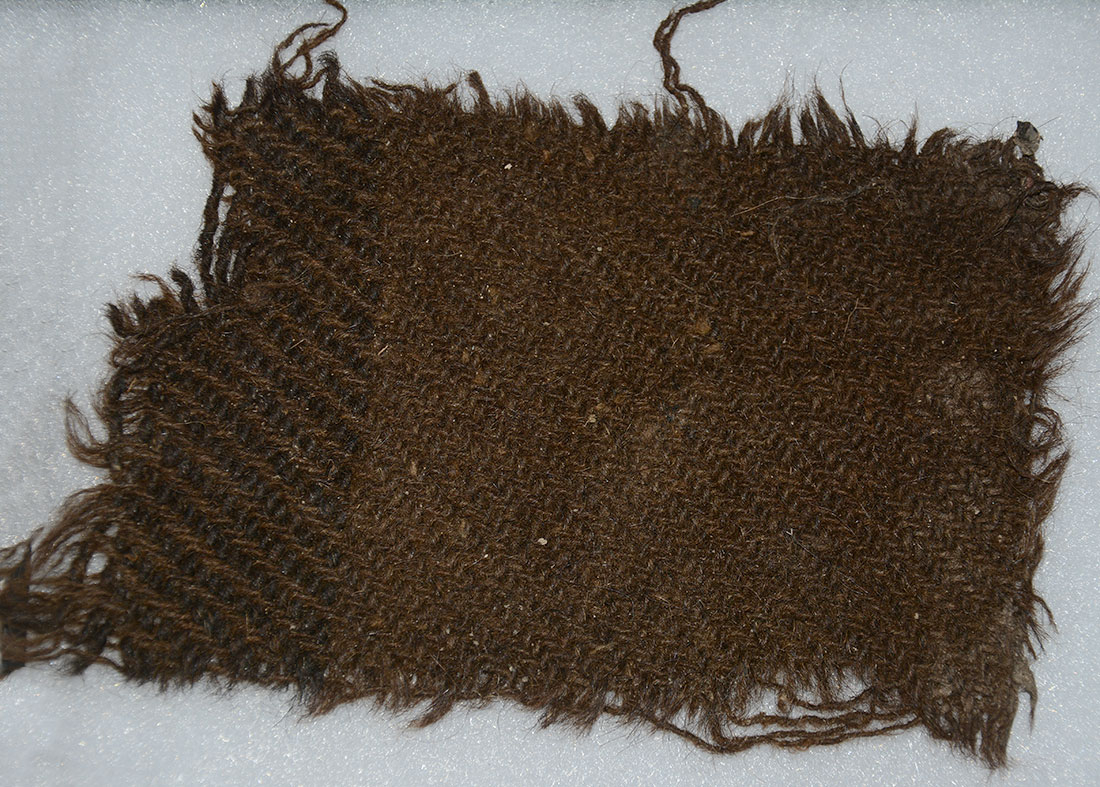site search
online catalog
PIECE OF CIVIL WAR ARMY BLANKET FROM FORT PEMBINA, NORTH DAKOTA

$95.00 SOLD
Quantity Available: None
Item Code: 1052-618
The army had vast stocks of Civil War material left over at the end of the war. These supplies, along with the reduction of the postwar army, meant U.S. troops were getting Civil War gear well into the 1870s. This piece of a regulation US Army Civil War blanket comes from excavations at Fort Pembina, ND, conducted on private property with the owner’s permission, a fort established in 1870 by troops of the 20th US Infantry and garrisoned until 1895. Uniform and equipment items recovered were in a remarkable state of preservation from the anaerobic conditions of the dig.
This piece is about the same size as many mementos of service retained by Civil War soldiers or their families where an army blanket was too practical not to be used, and used up, and too unimpressive to preserve or display. This shows the typical loose weave and diagonal wale of the army issue Civil War blanket and also part of the darker colored end stripe running along the edge. These blankets measured about 5 ½ feet by 7 feet, and featured dark end stripes and a loosely stitched “U.S.” made of yarn in the center. This has darkened only slightly. Officially designated as gray in color with black end stripes and letters, the logwood dies with iron mordants usually oxidized to a brownish color in short order, leaving most examples colored very close to this. They were replaced in the early 1870s by a better quality blanket in 1873 and one changing the color of the end stripes and the US in 1876.
Situated in the Red River Valley in North Dakota near the Canadian border, Fort Pembina was established in 1870 and in operation until 1895. Trading posts existed earlier in the area as part of the fur trade, and the first U.S. military post there was temporary- manned by a detachment of Minnesota troops in 1863-1864 following the 1862 Sioux uprising. In March 1870 a new fort was established south of the Pembina River and about 200 yards west of the Red River, completed by July and named in honor of Gen. George H. Thomas. The name was changed to Fort Pembina in September and the initial garrison consisted of two companies of the 20th US Infantry. Their main duty was to provide security for settlers worried about Sioux returning south from Canada, but the troops were more occupied with escorting boundary surveys along the Canadian border and preventing Fenian raids heading north into Canada.
The fort included enlistedmen’s barracks, officers’ quarters, guard house, ordnance storehouse, company kitchen, root house, laundress’s quarters, quarters for civilian employees, hospital and hospital servant’s house, a barn for the “hospital cow,” quartermaster and commissary offices and storehouse, stables, wagon shed, etc. The garrison reached peak strength in 1878 af 200, but the average was about 125 enlisted men and 8 officers. An October 1885 return listed 97 men, 2 field pieces, 1 mountain howitzer, 100 rifles, 19 pistols, 23 mules, and 9 wagons. By 1890 the post had just 23 men, and after an 1895 fire destroyed some 19 buildings it was decided to abandon the fort rather than rebuild, the last detachment left in September. The property was turned over to the Interior Department and later sold in 1902.
This is in remarkably good condition for an excavated piece and very displayable. It would fit a Civil War collection but also has a tight provenance to an Indian War post garrisoned by the U.S. army during the 1870s and 1880s Indian Wars. [sr][ph:L]
~~~~~~~~~~~~~~~~~~~~~~~~~~~~~~~~~~~
THIS ITEM, AS WITH ALL OTHER ITEMS AVAILABLE ON OUR WEB SITE,
MAY BE PURCHASED THROUGH OUR LAYAWAY PROGRAM.
CLICK HERE FOR OUR POLICIES AND TERMS.
THANK YOU!
Inquire About PIECE OF CIVIL WAR ARMY BLANKET FROM FORT PEMBINA, NORTH DAKOTA
For inquiries, please email us at [email protected]
Most Popular
Historical Firearms Stolen From The National Civil War Museum In Harrisburg, Pa »
Theft From Gravesite Of Gen. John Reynolds »
Selection Of Unframed Prints By Don Troiani »
Fine Condition Brass Infantry Bugle Insignia »
British Imported, Confederate Used Bayonet »
Scarce New Model 1865 Sharps Still In Percussion Near Factory New »
featured item
VERY RARE CONFEDERATE “ROPE BORDER” BELT PLATE
Dug condition stamped brass oval “rope border” belt plate. Unlike their US counterparts, these were not lead filled. These are not commonly found and can most often be traced back to the contractor Magee and George of New Orleans. The firm of… (1202-260). Learn More »
site search
Upcoming Events
APRIL 12-13: SPRING GETTYSBURG MILITARY ANTIQUES SHOW; All Star Events Complex Learn More »



